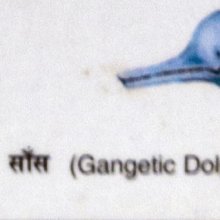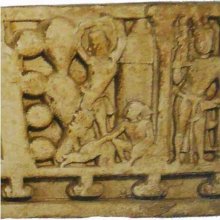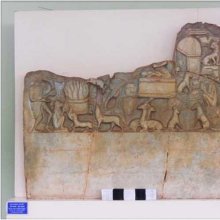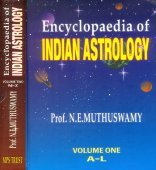Shasha, Sasa, Sāsa, Śaśa, Śāśa, Sasha, Shasa: 31 definitions
Introduction:
Shasha means something in Buddhism, Pali, Hinduism, Sanskrit, Marathi, Jainism, Prakrit, Hindi, biology. If you want to know the exact meaning, history, etymology or English translation of this term then check out the descriptions on this page. Add your comment or reference to a book if you want to contribute to this summary article.
The Sanskrit terms Śaśa and Śāśa can be transliterated into English as Sasa or Shasha, using the IAST transliteration scheme (?).
Images (photo gallery)
In Hinduism
Ayurveda (science of life)
Dietetics and Culinary Art (such as household cooking)
Source: Shodhganga: Dietetics and culinary art in ancient and medieval IndiaŚaśa (शश) refers to the “rabbit”, whose meat (māṃsa) is classified as “terrestrial” (bhūcara) according to the 17th century Bhojanakutūhala (dravyaguṇāguṇa-kathana), and is commonly found in literature dealing with the topics of dietetics and culinary art, also known as Pākaśāstra or Pākakalā.—The text [māṃsa-prakaraṇa] says the three fold division of meat [such as terrestrial (bhūcara)...]. Here different types of meat and their properties are discussed in detail. The terrestrial animals are [viz., śaśa (rabbit)].
Veterinary Medicine (The study and treatment of Animals)
Source: Shodhganga: Portrayal of Animal Kingdom (Tiryaks) in Epics An Analytical studyŚāsa (शास) refers to the Himalayan pika/Mouse hare (Ochotona roylei), according to scientific texts such as the Mṛgapakṣiśāstra (Mriga-pakshi-shastra) or “the ancient Indian science of animals and birds” by Hamsadeva, containing the varieties and descriptions of the animals and birds seen in the Sanskrit Epics such as the Ramayana and Mahabharata.
Agriculture (Krishi) and Vrikshayurveda (study of Plant life)
Source: Shodhganga: Drumavichitrikarnam—Plant mutagenesis in ancient IndiaŚaśa (शश) refers to the “hare”, the blood of which is used in certain recipes such as one for producing flowers and fruits round the year (puṣpaphala-āpatti), according to the Vṛkṣāyurveda by Sūrapāla (1000 CE): an encyclopedic work dealing with the study of trees and the principles of ancient Indian agriculture.
Unclassified Ayurveda definitions
Source: Wisdom Library: Āyurveda and botanyŚaśa (शश) is a Sanskrit word referring to the animal “hare”. The meat of this animal is part of the māṃsavarga (‘group of flesh’), which is used throughout Ayurvedic literature. The animal Śaśa is part of the sub-group named Jāṅgalamṛga, refering to “animals living in forests”. It was classified by Caraka in his Carakasaṃhitā sūtrasthāna (chapter 27), a classical Ayurvedic work. Caraka defined such groups (vargas) based on the dietic properties of the substance.
The meat of the hare (śaśa) is astringent, non-slimy, rough and cold. It is kaṭu in Vipāka. It is light, sweet and useful in sannipāta with mild vāta.
Source: archive.org: Sushruta samhita, Volume IŚaśa (शश)—Sanskrit word for an animal corresponding to “hare”. This animal is from the group called Bileśaya (‘hole-dwellers’ or ‘those which have a burrow’). Bileśaya itself is a sub-group of the group of animals known as Jāṅghala (living in high ground and in a jungle).
The flesh of the Shasha is sweet and astringent in taste. It reduces the Pittam and Kapham and neither produces nor subdues the Vāyu owing to its moderately cooling potency.

Āyurveda (आयुर्वेद, ayurveda) is a branch of Indian science dealing with medicine, herbalism, taxology, anatomy, surgery, alchemy and related topics. Traditional practice of Āyurveda in ancient India dates back to at least the first millenium BC. Literature is commonly written in Sanskrit using various poetic metres.
Purana and Itihasa (epic history)
Source: Cologne Digital Sanskrit Dictionaries: The Purana IndexŚaśa (शश).—The flesh of the hare, good for śrāddha.*
- * Matsya-purāṇa 17. 33.

The Purana (पुराण, purāṇas) refers to Sanskrit literature preserving ancient India’s vast cultural history, including historical legends, religious ceremonies, various arts and sciences. The eighteen mahapuranas total over 400,000 shlokas (metrical couplets) and date to at least several centuries BCE.
Dharmashastra (religious law)
Source: Prācyā: Animals and animal products as reflected in Smṛti textsŚaśa (शश) refers to the animal “Hare” or “Rabbit” (Lepus nigricolis).—The Smṛtis mention several domestic as well as wild animals that are enumerated in context of specifying expiation for killing them, the flesh being used as a dietary article to give satisfaction to the Manes (Pitṛs) in Śrāddha rites, the law of transmigration due to various sins committed as well as in the context of specifying gifts to be given on various occasions. These animals [viz., Śaśa] are chiefly mentioned in the Manusmṛti, Parāśarasmṛti [Chap.6], Gautamasmṛti [17.2 and 15.1], Śātātapasmṛti [II.45-54], Uśānasmṛti [IX.7-9; IX.12-13], Yājñavalkyasmṛti [I.170-171; I.175; I.258- 260], Viṣṇusmṛti [51.3;51.6;51.26;51.33;80.3-14], Uttarāṅgirasasmṛti [X.15-17], Prajāpatismṛti [Śrāddhatyājyavastuvarṇanam. 138-143], 9 Kāśyapasmṛti [Section on Prāyaścittavarṇanam], Vṛddha Hārītasmṛti [6.253-255] and Kātyāyanasmṛti [27.11].

Dharmashastra (धर्मशास्त्र, dharmaśāstra) contains the instructions (shastra) regarding religious conduct of livelihood (dharma), ceremonies, jurisprudence (study of law) and more. It is categorized as smriti, an important and authoritative selection of books dealing with the Hindu lifestyle.
Kavya (poetry)
Source: OpenEdition books: Vividhatīrthakalpaḥ (Kāvya)Sāsa (सास) in Prakrit is mentioned in the Vividhatīrthakalpa by Jinaprabhasūri (13th century A.D.): an ancient text devoted to various Jaina holy places (tīrthas).Cf. Prakrit khāsa.

Kavya (काव्य, kavya) refers to Sanskrit poetry, a popular ancient Indian tradition of literature. There have been many Sanskrit poets over the ages, hailing from ancient India and beyond. This topic includes mahakavya, or ‘epic poetry’ and natya, or ‘dramatic poetry’.
Jyotisha (astronomy and astrology)
Source: Wisdom Library: Brihat Samhita by VarahamihiraŚaśa (शश) refers to a “hare”, according to the Bṛhatsaṃhitā (chapter 3), an encyclopedic Sanskrit work written by Varāhamihira mainly focusing on the science of ancient Indian astronomy astronomy (Jyotiṣa).—Accordingly, “If, then the sun be black there will be fear from worms and reptiles; if it be ashy pale there will be fear from foreign princes; if the sun should appear with a hole that prince will perish in the star of whose nativity the sun then happens to be. If at other times than rising or setting the sun be of the colour of the blood of a hare [i.e., śaśa-rudhira-nibha] there will be war in the land; if he should appear like the moon, the reigning prince will be killed and a foreign prince will succeed immediately”.

Jyotisha (ज्योतिष, jyotiṣa or jyotish) refers to ‘astronomy’ or “Vedic astrology” and represents the fifth of the six Vedangas (additional sciences to be studied along with the Vedas). Jyotisha concerns itself with the study and prediction of the movements of celestial bodies, in order to calculate the auspicious time for rituals and ceremonies.
Sports, Arts and Entertainment (wordly enjoyments)
Source: archive.org: Syainika Sastra of Rudradeva with English Translation (art)Śaśa (शश) or Śaśaka refers to “hares” (which were commonly the victim of hunting), according to the Śyainika-śāstra: a Sanskrit treatise dealing with the divisions and benefits of Hunting and Hawking, written by Rājā Rudradeva (or Candradeva) in possibly the 13th century.—Accordingly, “Hunting by packs of dogs is that in which dogs are let loose at hares and other animals in arid tracts. In this success or otherwise depends upon the jumping (śaśa-pluta) of the hares and their falling into the dogs’ mouths. By their jumps and rebounds they produce abundance of laughter. [...]”.

This section covers the skills and profiencies of the Kalas (“performing arts”) and Shastras (“sciences”) involving ancient Indian traditions of sports, games, arts, entertainment, love-making and other means of wordly enjoyments. Traditionally these topics were dealt with in Sanskrit treatises explaing the philosophy and the justification of enjoying the pleasures of the senses.
General definition (in Hinduism)
Source: archive.org: Vedic index of Names and Subjects1) Śaśa (शश, ‘hare’) is found once in the Rigveda, where it is said to have swallowed a razor. The animal is occasionally mentioned later also.
2) Śāsa (शास) denotes in the Brāhmaṇas a ‘sword’ or ‘knife’.
3) Sasa (सस) in the Rigveda denotes ‘herb’ or ‘grass’. The word is also applied to the Soma plant and the sacrificial straw.
In Buddhism
Mahayana (major branch of Buddhism)
Source: Wisdom Library: LokottaravādaŚaśa (शश, “hare”) refers to a type of gemstone described in the “the second Avalokita-sūtra” of the Mahāvastu. Accordingly, when the Buddha (as a Bodhisattva) visited the bodhi-tree, several hunderd thousands of devas, in their place in the sky, adorned the Bodhisattva with several celestial substances. Then some of them envisioned the bodhi-tree as sparkling with śaśa gems.
The stories found in this part of the Mahāvastu correspond to the stories from the avidūre-nidāna section of the Nidāna-kathā. The Mahāvastu is an important text of the Lokottaravāda school of buddhism, dating from the 2nd century BCE.

Mahayana (महायान, mahāyāna) is a major branch of Buddhism focusing on the path of a Bodhisattva (spiritual aspirants/ enlightened beings). Extant literature is vast and primarely composed in the Sanskrit language. There are many sūtras of which some of the earliest are the various Prajñāpāramitā sūtras.
Tibetan Buddhism (Vajrayana or tantric Buddhism)
Source: academia.edu: The Structure and Meanings of the Heruka MaṇḍalaŚaśa (शश) is the name of a Vīra (hero) who, together with the Ḍākinī named Śaśī forms one of the 36 pairs situated in the Medinīcakra, according to the 10th century Ḍākārṇava chapter 15. Accordingly, the medinīcakra refers to one of the three divisions of the dharma-puṭa (‘dharma layer’), situated in the Herukamaṇḍala. The 36 pairs of Ḍākinīs and Vīras [viz., Śaśa] are yellow in color; the shapes of their faces are in accordance with their names; they have four arms; they hold a skull bowl, a skull staff, a small drum, and a knife.

Tibetan Buddhism includes schools such as Nyingma, Kadampa, Kagyu and Gelug. Their primary canon of literature is divided in two broad categories: The Kangyur, which consists of Buddha’s words, and the Tengyur, which includes commentaries from various sources. Esotericism and tantra techniques (vajrayāna) are collected indepently.
Biology (plants and animals)
Source: Google Books: CRC World Dictionary (Regional names)Sasa in Philippines is the name of a plant defined with Nypa fruticans in various botanical sources. This page contains potential references in Ayurveda, modern medicine, and other folk traditions or local practices It has the synonym Nipa arborescens Wurmb ex H. Wendl. (among others).
Example references for further research on medicinal uses or toxicity (see latin names for full list):
· Icon. Pl. Asiat. (1851)
· Dissert. Inaug. Med. Sagu (1757)
· Botanica Acta (1997)
· Flora Cochinchinensis (1790)
· Kongl. Vetenskaps Academiens Nya Handlingar (1782)
· Plant Systematics and Evolution (1994)
If you are looking for specific details regarding Sasa, for example chemical composition, extract dosage, pregnancy safety, side effects, health benefits, diet and recipes, have a look at these references.

This sections includes definitions from the five kingdoms of living things: Animals, Plants, Fungi, Protists and Monera. It will include both the official binomial nomenclature (scientific names usually in Latin) as well as regional spellings and variants.
Languages of India and abroad
Pali-English dictionary
Source: BuddhaSasana: Concise Pali-English Dictionarysasa : (m.) a hare.
Source: Sutta: The Pali Text Society's Pali-English DictionarySāsa, (Sk. śvāsa, fr. śvas) asthma A. V, 110; J. VI, 295. (Page 707)
— or —
Sasa, (Vedic śaśa, with Ohg. haso=E. hare to Lat. canus grey, greyish-brown; cp. Ags. hasu) a hare, rabbit Dh. 342; J. IV, 85; of the hare in the moon J. IV, 84 sq.; sasôlūkā (=sasā ca ulūkā ca) J. VI, 564.

Pali is the language of the Tipiṭaka, which is the sacred canon of Theravāda Buddhism and contains much of the Buddha’s speech. Closeley related to Sanskrit, both languages are used interchangeably between religions.
Marathi-English dictionary
Source: DDSA: The Molesworth Marathi and English Dictionarysasā (ससा).—m (śaśa S) A hare, Lepus nigricollis. F. Cuvier. 2 (By abridgment for sasāṇā) A falcon.
Source: DDSA: The Aryabhusan school dictionary, Marathi-Englishsasā (ससा).—m A hare; also sasāṇā m A falcon.
Marathi is an Indo-European language having over 70 million native speakers people in (predominantly) Maharashtra India. Marathi, like many other Indo-Aryan languages, evolved from early forms of Prakrit, which itself is a subset of Sanskrit, one of the most ancient languages of the world.
Sanskrit dictionary
Source: DDSA: The practical Sanskrit-English dictionaryŚaśa (शश).—
1) A hare, rabbit; Manusmṛti 3.27;5.18.
2) The spots on the moon (which are popularly considered to resemble the form of a hare).
3) One of the four classes into which men are divided by erotic writers; thus defined;-मृदुवचनसुशीलः कोमलाङ्गः सुकेशः सकलगुणनिधानं सत्यवादी शशोऽयम् (mṛduvacanasuśīlaḥ komalāṅgaḥ sukeśaḥ sakalaguṇanidhānaṃ satyavādī śaśo'yam) Śabdak.; see Ratimañjarī 35 also.
4) The Lodhra tree.
5) Gum-myrrh.
6) An antelope.
Derivable forms: śaśaḥ (शशः).
--- OR ---
Śāśa (शाश).—a. Belonging to, or coming from a hare.
--- OR ---
Śāsa (शास).—Ved.
1) An order, command.
2) Praise (stuti).
Derivable forms: śāsaḥ (शासः).
--- OR ---
Sāsa (सास).—a. Having a bow; स सासिः सासुसूः सासो येयाययाययाययः (sa sāsiḥ sāsusūḥ sāso yeyāyayāyayāyayaḥ) Kirātārjunīya 15.5.
Source: Cologne Digital Sanskrit Dictionaries: Edgerton Buddhist Hybrid Sanskrit DictionaryŚaśa (शश).—or (v.l.) śaśaka (nt. or m.), a kind of gem: anye devā śaśehi (v.l. śaśakehi) maṇiratanehi samalaṃ- kṛtaṃ bodhivṛkṣaṃ saṃjānanti Mahāvastu ii.311.4 (prose). Un- recorded.
Source: Cologne Digital Sanskrit Dictionaries: Shabda-Sagara Sanskrit-English DictionaryŚaśa (शश).—m.
(-śaḥ) 1. A hare or rabbit. 2. The Lod'h-tree, (Symplocos racemosa.) 3. Gum myrrh. 4. A man of mild and virtuous character, but uxorous and woman-led, one of the four characters in which men are classed by erotic writers. 5. The spots on the moon, supposed to resemble the figure of a hare. E. śaś to go by leaps or jumps, aff. ac .
--- OR ---
Sāsa (सास).—f.
(-sā) Having a bow.
Source: Cologne Digital Sanskrit Dictionaries: Benfey Sanskrit-English DictionaryŚaśa (शश).—[śaś + a] (originally śasa, cf. [Old High German.] haso; [Anglo-Saxon.] hara), m. 1. A hare, [Pañcatantra] ii. [distich] 79; or rabbit. 2. The spots on the moon, supposed to resemble the figure of a hare (cf. śaśadhara, sqq.). 3. Gum myrrh. 4. A tree, Symplocos racemosa.
Source: Cologne Digital Sanskrit Dictionaries: Cappeller Sanskrit-English DictionaryŚaśa (शश).—[masculine] hare (seen also in the spot of the moon).
--- OR ---
Śāśa (शाश).—[adjective] relating to a hare, leporine.
--- OR ---
Śāsa (शास).—1. [masculine] order, command.
--- OR ---
Śāsa (शास).—2. [masculine] punisher, ruler.
--- OR ---
Śāsa (शास).—3. [masculine] knife.
--- OR ---
Sasa (सस).—[substantive] herb, grass.
--- OR ---
Saśā (सशा).—sharpen, whet; excite, make eager or ready for ([dative]). — Cf. ni/śita, sa/śita.
Saśā is a Sanskrit compound consisting of the terms sa and śā (शा).
Source: Cologne Digital Sanskrit Dictionaries: Monier-Williams Sanskrit-English Dictionary1) Śasa (शस):—[from śaṃs] mfn. reciting (See uktha-śas, -śasa).
2) Śaśa (शश):—[from śaś] m. a hare, rabbit, or antelope (the markings on the moon are supposed to resemble a hare or rabbit), [Ṛg-veda] etc. etc. (for śaśasya vrata See under karṣū, p.260)
3) [v.s. ...] a kind of meteor, [Atharva-veda v, 17, 4]
4) [v.s. ...] Name of a man born under a [particular] constellation, [Varāha-mihira’s Bṛhat-saṃhitā]
5) [v.s. ...] a man of mild character and easily led (one of the four classes into which men are divided by erotic writers, the other three being aśva, mṛga and vṛṣan), [cf. Lexicographers, esp. such as amarasiṃha, halāyudha, hemacandra, etc.]
6) [v.s. ...] the Lodhra tree, Symplocos Racemosa, [Kādambarī]
7) [v.s. ...] gum-myrrh, [cf. Lexicographers, esp. such as amarasiṃha, halāyudha, hemacandra, etc.]
8) [v.s. ...] Name of a part of Jambu-dvīpa, [Monier-Williams’ Sanskrit-English Dictionary]
9) [from śaś] cf. [according to] to some, [Greek] κεκήν; [according to] to others, śaśa is for śasa and is connected with [German] haso, Hase; [English] hare.
10) Śasā (शसा):—[from śas] f. idem, [Ṛg-veda v, 41, 18] ([Sāyaṇa] = stutyā, [from] √śaṃs)
11) Śāśa (शाश):—mfn. ([from] śaśa) belonging to or coming from a hare, [Yājñavalkya; Caraka]
12) Śāsa (शास):—[from śās] 1. śāsa m. order, command, [Ṛg-veda]
13) [v.s. ...] (śāsa) a commander, ruler, chastiser, [Ṛg-veda]
14) [v.s. ...] Name of the hymn x, 152 [Aitareya-brāhmaṇa]
15) [v.s. ...] of its author (having the [patronymic] Bhāradvāja), [Anukramaṇikā]
16) [from śās] 2. śāsa m. (for 1. See p. 1068, col. 3) a butcher’s knife, [Brāhmaṇa; ???]
17) Ṣasa (षस):—([probably]) = khākhasa, poppy, [Catalogue(s)]
18) Sasa (सस):—[from sas] mfn. sleeping, [Naighaṇṭuka, commented on by Yāska iv, 2]
19) [v.s. ...] m. Name of an Ātreya (author of [Ṛg-veda v, 21])
20) [v.s. ...] m. or n. (?) herb, grass, corn (cf. sasya), [Ṛg-veda]
21) Sāsa (सास):—m. (√2. as) and bow, [Monier-Williams’ Sanskrit-English Dictionary]
Source: Cologne Digital Sanskrit Dictionaries: Yates Sanskrit-English Dictionary1) Śaśa (शश):—(śaḥ) 1. m. A hare or rabbit; lodh tree; gum myrrh; mild uxorious man; spots on the moon.
2) vindu (nduḥ) 2. m. Vishnu; a sovereign; the moon.
Source: DDSA: Paia-sadda-mahannavo; a comprehensive Prakrit Hindi dictionary (S)Śaśa (शश) in the Sanskrit language is related to the Prakrit word: Sasa.
[Sanskrit to German]
Sanskrit, also spelled संस्कृतम् (saṃskṛtam), is an ancient language of India commonly seen as the grandmother of the Indo-European language family (even English!). Closely allied with Prakrit and Pali, Sanskrit is more exhaustive in both grammar and terms and has the most extensive collection of literature in the world, greatly surpassing its sister-languages Greek and Latin.
Hindi dictionary
Source: DDSA: A practical Hindi-English dictionary1) Śaśa (शश):—(nm) a rabbit, hare; the number six; (a) six; ~[māhī] six-monthly, half-yearly.
2) Sāsa (सास) [Also spelled saas]:—(nf) mother-in-law, mother of wife or husband; —[merī ghara nahīṃ mujhe kisī kā ḍara nahīṃ] when the cat is away, the mice will play.
...
Prakrit-English dictionary
Source: DDSA: Paia-sadda-mahannavo; a comprehensive Prakrit Hindi dictionary1) Sasa (सस) in the Prakrit language is related to the Sanskrit word: Sas.
2) Sasa (सस) also relates to the Sanskrit word: Śaśa.
3) Sasā (ससा) also relates to the Sanskrit word: Svasṛ.
4) Sāsa (सास) also relates to the Sanskrit word: Śās.
5) Sāsa (सास) also relates to the Sanskrit word: Katha.
6) Sāsa (सास) also relates to the Sanskrit word: Śvāsa.
7) Sāsa (सास) also relates to the Sanskrit words: Śasya, Sasya.
Prakrit is an ancient language closely associated with both Pali and Sanskrit. Jain literature is often composed in this language or sub-dialects, such as the Agamas and their commentaries which are written in Ardhamagadhi and Maharashtri Prakrit. The earliest extant texts can be dated to as early as the 4th century BCE although core portions might be older.
Kannada-English dictionary
Source: Alar: Kannada-English corpusŚaśa (ಶಶ):—
1) [noun] any of various swift, burrowing mammals (order Lagomorpha), characterised by soft fur, long ears, a stubby tail, and the bearing of naked young ones; a rabit or hare.
2) [noun] the black spots on the moon which are likened to a hare.
3) [noun] the tree Symplocos racemosa of Sympolocaceae family; the lodh tree.
4) [noun] a deer or antelope.
5) [noun] a man of mild character (one of the four classes in to which men are divided in erotic science).
6) [noun] one of the five classes of men based on the physical size.
--- OR ---
Sāsa (ಸಾಸ):—
1) [noun] a bold, usu. risky undertaking; a hazardous action; an adventure.
2) [noun] the quality of being bold, brave, valorous.
--- OR ---
Sāsa (ಸಾಸ):—
1) [noun] the air taken in to the lungs and let out; breath.
2) [noun] the act of exhaling.
Kannada is a Dravidian language (as opposed to the Indo-European language family) mainly spoken in the southwestern region of India.
Nepali dictionary
Source: unoes: Nepali-English DictionarySāsa (सास):—n. breath;
Nepali is the primary language of the Nepalese people counting almost 20 million native speakers. The country of Nepal is situated in the Himalaya mountain range to the north of India.
See also (Relevant definitions)
Starts with (+23): Sasalanchana, Sasavisana, Shashabhridbhrit, Shashabhrit, Shashabindava, Shashabindu, Shashada, Shashadana, Shashadanaka, Shashadhara, Shashadhara acarya, Shashadharacarya, Shashadharamala, Shashadhariya, Shashadharman, Shashagada, Shashaghataka, Shashaghatin, Shashaghna, Shashaghni.
Query error!
Full-text (+214): Shashanka, Sasavisana, Shashadhara, Sasalanchana, Shashada, Sasham, Shashadana, Shashabhrit, Shashabindu, Shashashringa, Goshashasa, Shashaplutaka, Shashaloman, Shashasthali, Shashayana, Shashorna, Parishasa, Duhshasa, Sarvashasa, Shashasana.
Relevant text
Search found 98 books and stories containing Shasha, Sa-śā, Sa-sa, Sa-sha, Sasa, Sāsa, Śaśa, Śāsa, Sasā, Śāśa, Saśā, Śasa, Śasā, Ṣasa, Sasha, Shaasha, Shasa; (plurals include: Shashas, śās, sas, shas, Sasas, Sāsas, Śaśas, Śāsas, Sasās, Śāśas, Saśās, Śasas, Śasās, Ṣasas, Sashas, Shaashas, Shasas). You can also click to the full overview containing English textual excerpts. Below are direct links for the most relevant articles:
Rig Veda (translation and commentary) (by H. H. Wilson)
Maha Prajnaparamita Sastra (by Gelongma Karma Migme Chödrön)
The Śaśa-Jātaka < [I. Puṇyakriyāvastu consisting of generosity]
Part 10 - Tittiriyaṃ brahmacariyaṃ (the religious life of the pheasant) < [Chapter XX - The Virtue of Generosity and Generosity of the Dharma]
Asvalayana-grihya-sutra (by Hermann Oldenberg)
Preksha meditation: History and Methods (by Samani Pratibha Pragya)
Appendix 1 - Mūlapāṭha of Jayācārya’s Texts, etc.
2.1. Meditative Practices of Ācārya Bhikṣu and Muni Hemarāja < [Chapter 3 - The History of Meditation in Terāpanth]
Notices of Sanskrit Manuscripts (by Rajendralala Mitra)
Matangalila and Hastyayurveda (study) (by Chandrima Das)
Related products







